Além de ser co-apresentador de Ellen Page no programa Viceland's série de documentários de viagem GaycationIan Daniel é um polímata criativo que trabalha com teatro, cinema e arte. Ele conheceu Page em 2008 em uma ecovila e, quando ela apresentou o conceito de um programa de viagens LGBTQ ao copresidente do canal de TV Vice, Spike Jonze, ela quis Daniel ao seu lado por causa da amizade íntima e da experiência dele em documentários.
O resultado é uma dinâmica na tela que fará seu coração explodir a cada episódio. Quer você esteja confrontando Ted Cruz na Feira Estadual de Iowa ou testemunhando desajeitadamente Quando você vê a história de um homem que se assume para sua mãe no Japão, a dupla mantém um equilíbrio perfeito entre sensibilidade e força. Enquanto viajam pelo mundo explorando questões LGBTQ, eles cuidam um do outro e das pessoas que encontram com profunda ternura.
Quando descobrimos sobre A prática curatorial de DanielPor isso, entramos em contato com ele para ver se ele poderia montar uma galeria on-line de artistas que discutem questões semelhantes destacadas em Gaycation. Quem são os artistas que estão fazendo trabalhos importantes sobre a cultura queer? Quais são LGBTQ-Você sabe o que você acha de peças focadas em seu trabalho? Daniel aceitou o desafio e tirou um tempo de sua agenda lotada para nos enviar uma incrível coleção de trabalhos que deveriam estar no radar de todos.
De minhas experiências em GaycationCom o tempo, passei a ter uma compreensão muito mais profunda de como o gênero, a sexualidade, o sexo e a raça são expressos e tratados globalmente e isso influenciou os artistas aos quais presto atenção hoje.
Veja a seguir o que ele nos contou sobre o trabalho que fez a curadoria para Revista Format:
"Em 2013, eu co-curadoria de uma exposição com a curadora Sara Reisman, chamada Ainda age que se concentrou principalmente em artistas que se envolveram com a quietude, a paralisação e a desaceleração como atos de resistência, protesto e oposição. Acho que alguns dos temas dessa exposição realmente ficaram comigo e sinto que são mais relevantes do que nunca, considerando a ansiedade em torno dessa eleição e o rumo que os Estados Unidos e muitos outros países estão tomando política e socialmente. Tenho observado como a arte se conecta com o engajamento político e com os artistas que estão nos provocando a questionar como todos nós nos conectamos com preocupações sociais e políticas mais amplas.
"De minhas experiências em GaycationCom o tempo, passei a ter uma compreensão muito mais profunda de como o gênero, a sexualidade, o sexo e a raça são expressos e tratados globalmente e isso influenciou os artistas aos quais presto atenção hoje.
"Nesta lista, estou compartilhando alguns trabalhos de artistas que tenho observado mais recentemente, artistas que estão usando seu trabalho para conectar o corpo físico, o gênero, a sexualidade, a estranheza, a liberdade sexual, a identidade e a raça ao presente político."
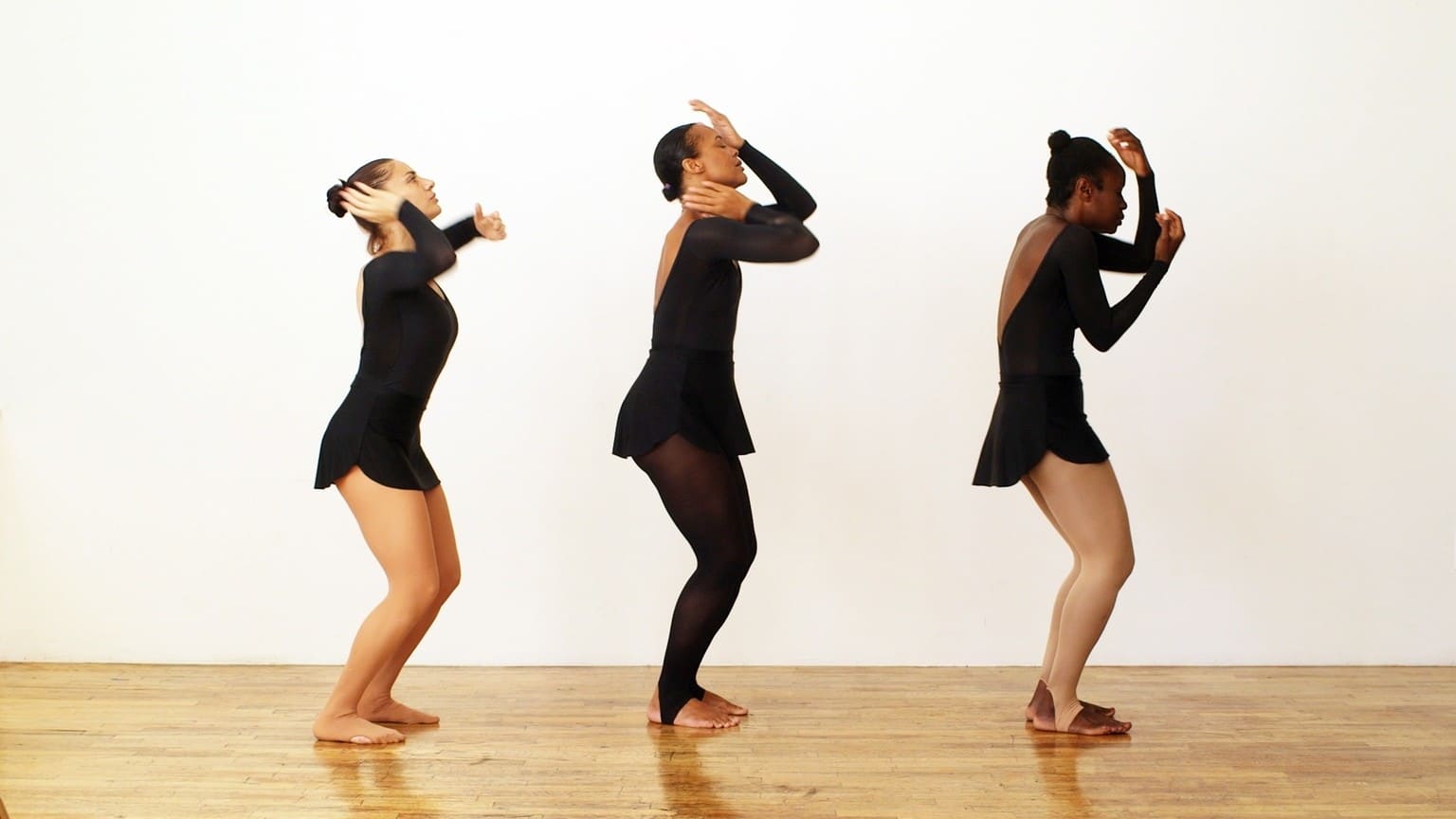
Número 19, 2015, fotografia colorida. Cortesia do artista e da Galeria David Castillo
CÓDIGO por Xaviera Simmons
CÓDIGO é um artista interdisciplinar de trabalho conceitual Xaviera Simmons. Ele usa performances baseadas em movimento e instalações fotográficas para meditar sobre gestos queer na arte e na cultura dancehall. Ele pede que o público reflita sobre "os métodos que usamos para construir papéis de gênero e também sobre como abordamos tópicos de sexualidade, liberdade estética e sensualidade". O que é uma "pose masculina"? O que é uma "pose masculina"? O que é uma "pose feminina"? Essas perguntas são feitas e combinadas com o "puro prazer" da expressão física.
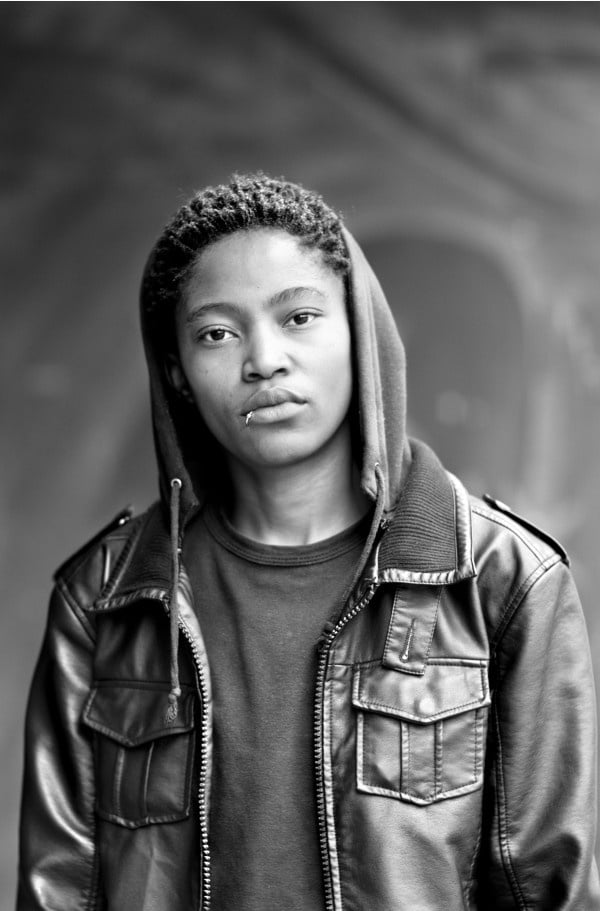
Fotografia em gelatina e prata, 34 x 24
##Xana Nyilenda, Newtown, Johanesburgo, 2001 por Zanele Muholi.
Fotógrafo Zanele Muholi é mais conhecida por seu trabalho Rostos e fases que traça o perfil da comunidade de lésbicas e transgêneros da África do Sul. A série consiste em oitenta e sete retratos fotografados entre 2007 e 2014. De acordo com a New York Times, ''Rostos e fases começou como uma reação a uma escalada de crimes de ódio e assassinatos homofóbicos na África do Sul. Muholi acreditava que a fotografia poderia normalizar e acabar com os medos da homossexualidade e, ao fazê-lo, tornar a vida mais segura para mulheres como ela."

Vídeo do trailer da performance. Berlim, Alemanha. Instituto KW de Arte Contemporânea, 3 de março de 2016
CLAPBACK por niv Acosta
Formado em dança contemporânea, baseado em Nova York niv Acosta busca a performance de dança, a escultura e os fóruns educacionais como formas de considerar questões políticas de raça e gênero. Sua nova performance foi concebida para a instituição como uma superfície branca e em branco, que ele pretende marcar por meio de sua ação coreográfica, movendo-se através de - e contra - seu público.
Sobre seu desempenho CLAPBACK ele escreve: "A taxa de assassinatos de negros pela polícia nos Estados Unidos em 2015 nos levou a um número chocante de 1.134 mortes até o final do ano. CLAPBACK é, em parte, uma homenagem e, em parte, uma previsão para o futuro; um twerk para cada morte ocorrida nas mãos da polícia. CLAPBACK é sobre o poder das bundas negras de se livrar de nossas opressões pós-coloniais, transcender a expectativa de morrer jovem, mudar o campo gravitacional da Terra e expulsar trolls malignos".
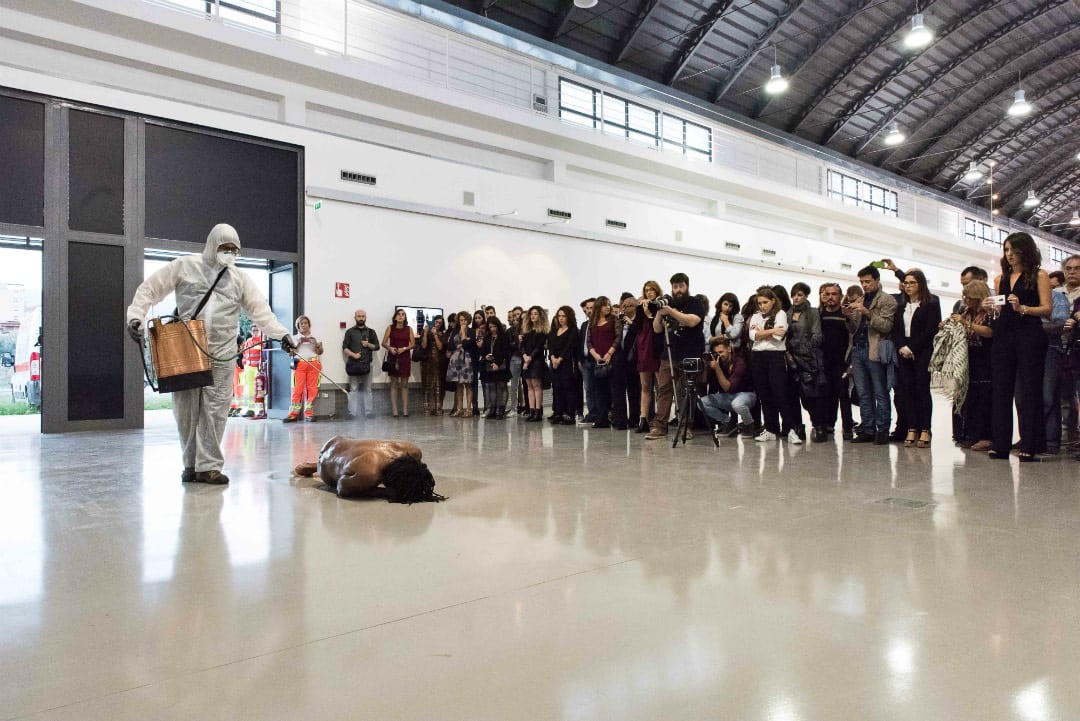
Vista da performance, Tatuare la storia, Zisa Zona Arti Contemporanee (ZAC), Palermo, Itália
Peste por Carlos Martiel.
Com sede em Nova York e Havana, Carlos Martiel usa a arte performática para confrontar a ética agressiva do mundo - passado e presente. Ele frequentemente usa seu próprio corpo para demonstrar danos e violência. Nesta peça intitulada PesteNo filme, um exterminador de pragas fumiga seu corpo nu com inseticida para baratas como um comentário sobre as políticas xenófobas europeias históricas e modernas geradas contra imigrantes.

Vídeo, março de 2016, gravado pelo The Laura Flanders Show
##"Fetiche Branco" por DarkMatter
Conhecidos coletivamente como Matéria escuraAlok Vaid-Menon e Janani Balasubramanian são uma dupla de arte performática sul-asiática transidentificada que recentemente decidiu se concentrar em suas práticas artísticas solo. Eles já se apresentaram em todo o mundo e estenderam sua arte às mídias sociais com um Instagram (agora dirigido exclusivamente por Vaid-Menon), com 44 mil seguidores. Em seu trabalho, eles se opõem às narrativas estereotipadas da experiência trans. Será interessante ver o que Vaid-Menon e Balasubramanian criarão como artistas individuais.
Em sua peça engraçada e superficial, "White Fetish", Vaid-Menon e Balasubramanian trocam jogos de palavras com frases de grande veracidade. A força vem tanto de suas vozes fortes quanto da dor real em seus olhos. Ela confronta o espectador com realidades que podem facilmente ser ridicularizadas.
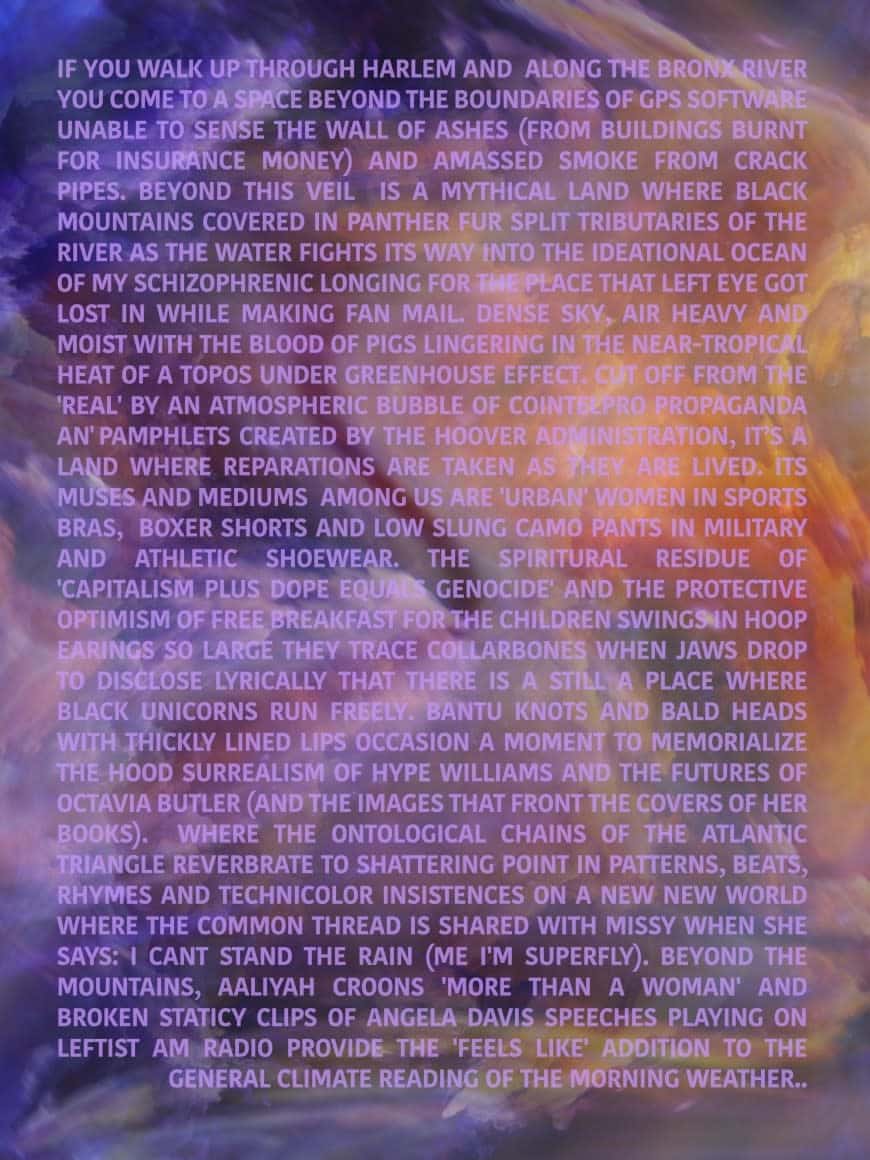
Impressão a jato de tinta, 40 x 30 polegadas
Sem título (Casual Power) por Juliana Huxtable
Os temas de Juliana Huxtable(raça, gênero, queerness, identidade) são expressos por meio de uma gama diversificada de meios artísticos, incluindo vida noturna, mídia social e trabalho baseado em texto. Ela usa seu próprio corpo e experiências para criticar o olhar e as percepções das normas.
Em Sem título (Casual Power)Huxtable imprimiu um poema em prosa sobre os problemas enfrentados pela comunidade negra de Nova York. Suas imagens vívidas misturam referências da cultura pop com filosofia. É uma obra que atrai o leitor com o texto e o assombra com a ideologia.

Vídeo da apresentação no Broad Museum, Los Angeles, 2 de abril de 2016
Os poderes que existem por Heather Cassils
Usar seu corpo como uma escultura, Cassils foi identificado pelo Huffington Post como "um dos dez artistas transgêneros que estão mudando o cenário da arte contemporânea". Suas performances ao vivo desafiam a verdade implícita do documentário. O treinamento físico dos corpos, em conjunto com a estética gay masculina e a arte corporal, são temas essenciais do trabalho.
Os poderes que existem é uma performance sobre "forças cíclicas de violência que tentam governar e regular os corpos dos 'outros'". Eles usam coreografia de luta com faróis piscantes e ruído de áudio de sinal de rádio para mostrar a opressão da cultura americana contemporânea.
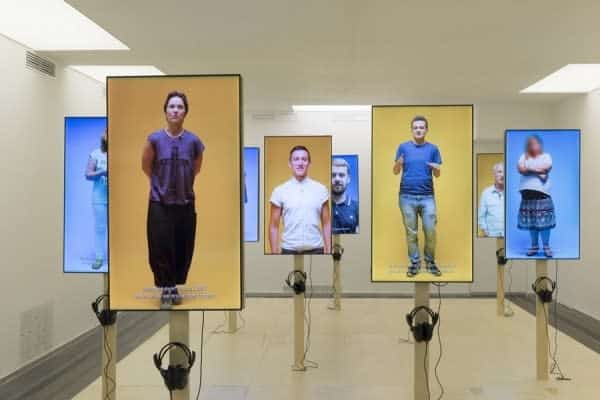
Vista da instalação, PinchukArtCentre, Kiev, Ucrânia 31 de outubro de 2015 - 17 de abril de 2016
Patriotas, cidadãos, amantes... por Carlos Motta
Vencedor do prêmio Future Generation Art Prize de 2014, Motta desenvolvido Patriotas, cidadãos, amantes... com o jornalista ucraniano Maxim Ivanukha. A obra é composta por "dez entrevistas urgentes com ativistas ucranianos LGBTQ e queer que discutem a situação crítica e terrível da vida de lésbicas, gays, trans e intersexuais na Ucrânia em tempos de guerra". Ele dá voz aos alvos vulneráveis da homofobia violenta que Motta acredita estar sendo ofuscada pela crise econômica e política da Ucrânia.
Bônus: Você pode saber mais sobre os ativistas em destaque na obra Gaycationda Ucrânia.
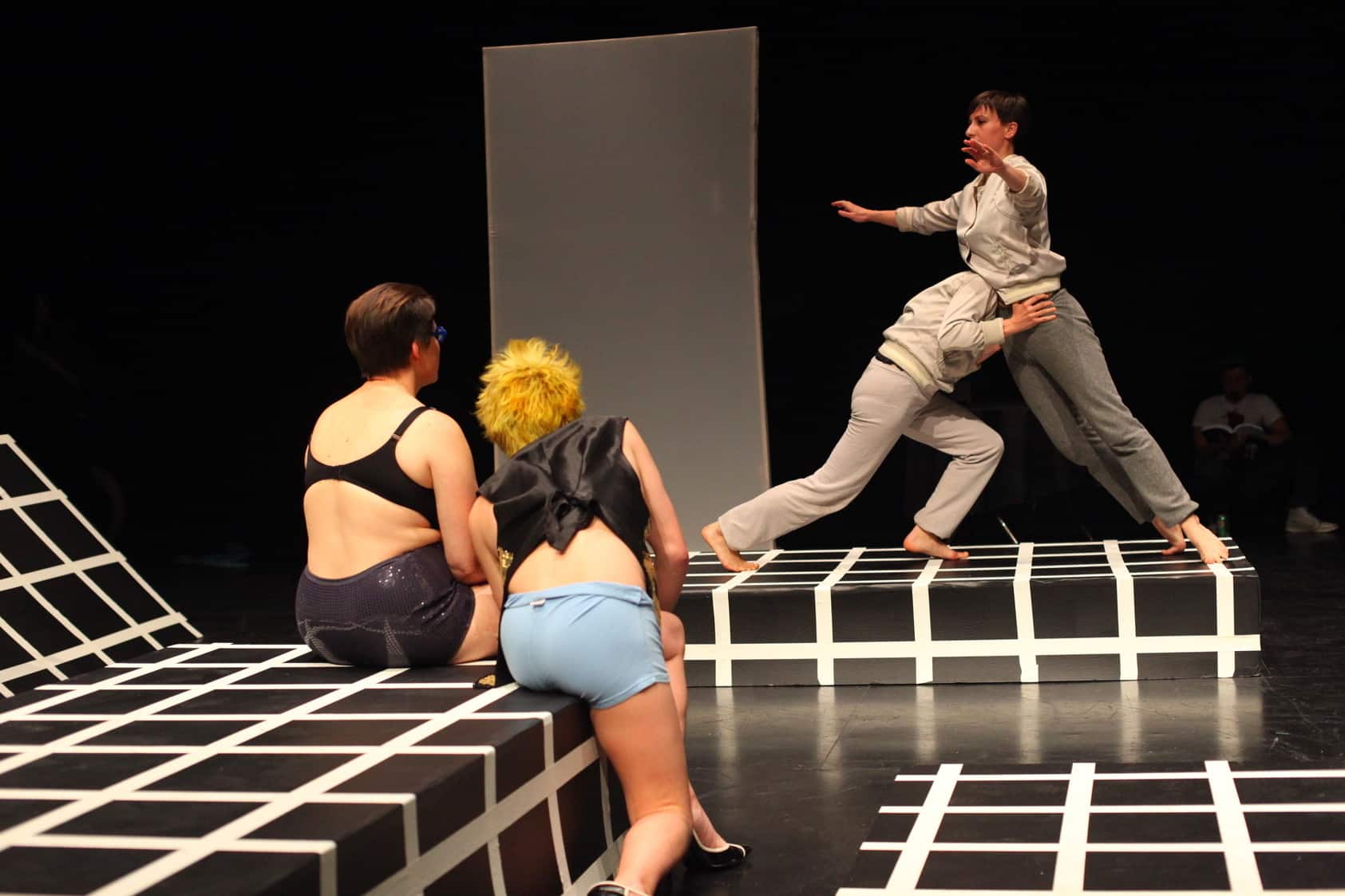
Exibição da performance, The Kitchen, Nova York, 5 e 6 de maio de 2011
Um bar gay chamado Everywhere (com fantasias e sem prática) por Emily Roysdon
Emily Roysdon é uma artista interdisciplinar baseada em Nova York e Estocolmo. É editora e cofundadora do jornal feminista queer e do coletivo de artistas LTTR. A fusão da política com a imaginação é um tema frequente em seu trabalho. Composição de letras para bandas A faca e JD Samson & Men é apenas um exemplo da diversidade de sua prática artística.
Um bar gay chamado Everywhere (com fantasias e sem prática) é uma peça de performance colaborativa em que Roysdon pede a seus artistas que especulem sobre um bar gay que abriga Susan Sontag. O tempo passa, e ela ainda vive e trabalha lá. O estilo "solto" capta a "luta e a ingenuidade da vida queer". Roysdon usa cenários e design de luz para criar um senso de tempo desconexo.
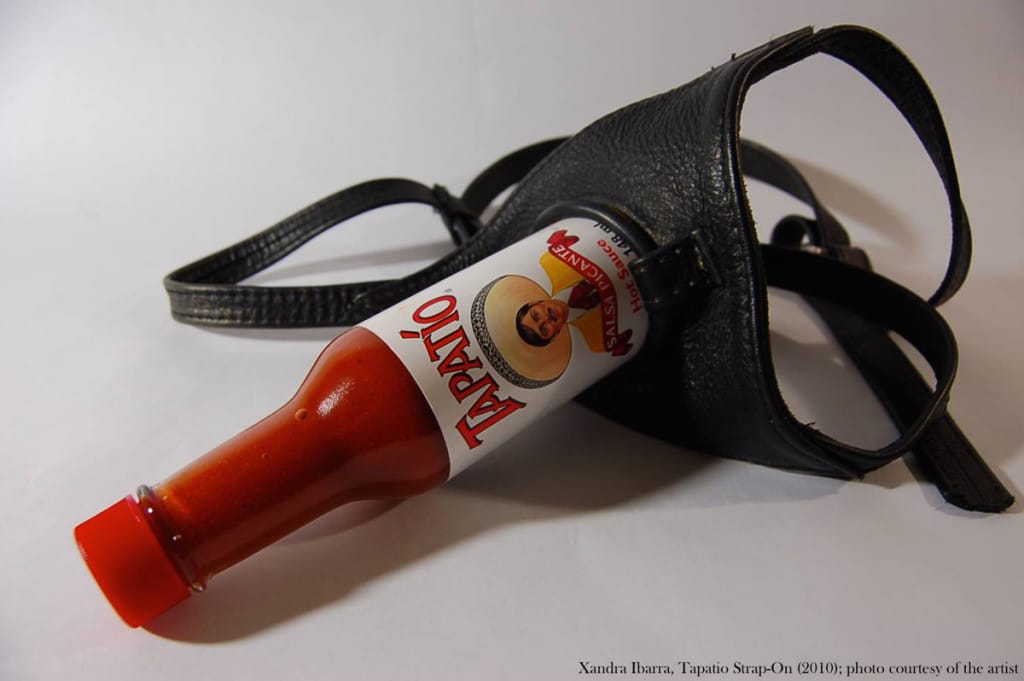
Couro, borracha, 9,5″ x 16″, dimensões variáveis
Fucked Life Strap Ons por Xandra Ibarra
Xandra Ibarra é uma artista performática baseada em Oakland, na fronteira entre El Paso e Juarez, que usa modos hiperbolizados de racialização e sexualização para testar os limites entre seu próprio corpo e a colonialidade, a brancura compulsória e a mexicanidade. Sua prática integra performance, atos sexuais e burlesco com vídeo, fotografia e objetos.
Sua peça "Fucked Life Strap Ons" pega uma garrafa de molho picante Tapatio e a coloca em um arnês de couro. É engraçado, burlesco e desafia nossa visão da cultura queer latina. Em seu trabalho "Spic(y) Appropriates", Ivan Ramos escreve que essa obra de arte "não oferece um corpo sem órgãos, mas um corpo jocoso que sintetiza e devolve as contradições do corpo mexicano e sua comida, sua boca, sua vagina, seu pau picante".
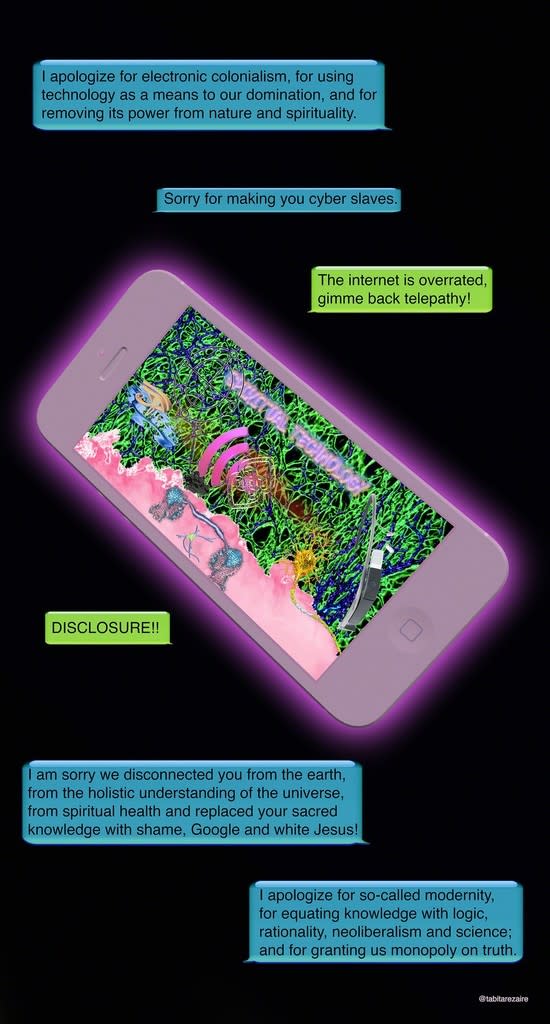
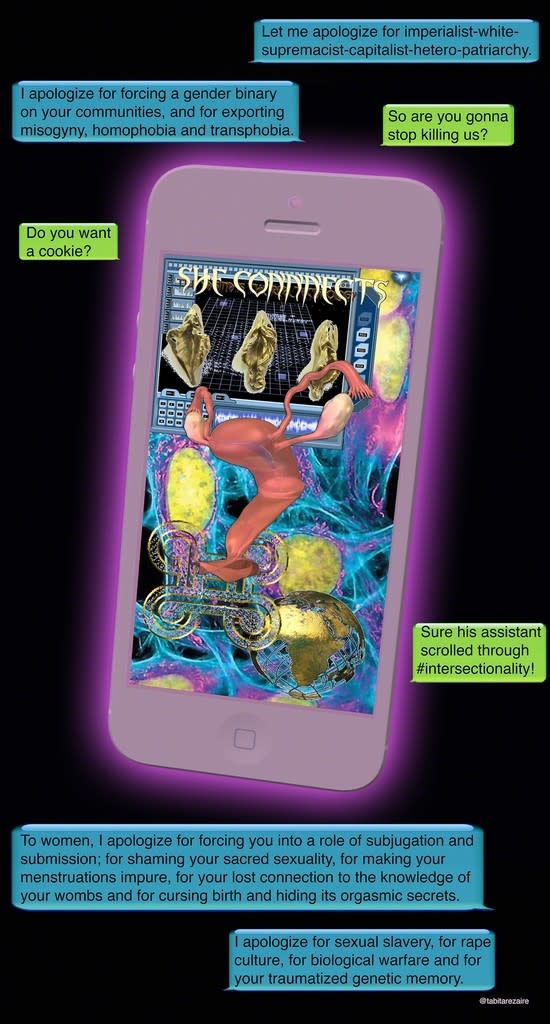
Impressão digital montada em Diasec, 39 2/5 × 21 7/10 pol.
Sorry for Real III/IV de Tabita Rezaire
Para o artista franco-guianense e dinamarquês RezairePara você, a Internet é um espaço colonializado. Sua prática tem como objetivo chamar a atenção e resistir à tendência do mundo on-line para o racismo, a intolerância e a opressão - uma forma de ativismo digital que se manifestou em vídeos em tons de neon, desde tutoriais de autocuidado até explorações da homossexualidade em Moçambique. O trabalho de Razaire foi apresentado em uma série de exposições em 2016, especialmente na 9ª edição do Bienal de Berlim e Sorry For Real no Museu de Artes Contemporâneas da Diáspora Africana no Brooklyn. (Nessa última, ela imaginou uma série de textos do mundo ocidental pedindo desculpas àqueles afetados, entre outras coisas, pela escravidão, pelo apartheid e pelo capitalismo). No próximo ano, a artista de novas mídias fará sua primeira exposição individual na Goodman Gallery e concluirá sua atual residência na Holanda com um trabalho encomendado para o Impakt Festival em Utrecht.

Vídeo. Dirigido por M. Lamar com animação de Sabin Calvert
Tentando deixar meu corpo por M. Lamar
M. Lamar é um compositor que trabalha com ópera, metal, performance, vídeo, escultura e instalação para criar narrativas amplas de transformações radicais. Para o New YorkerEm um artigo publicado na revista "The New York Times", Hilton Als escreveu que Lamar "desconstrói a persona da diva, ao mesmo tempo em que se envolve em uma alta qualidade semelhante à da diva". Seu vídeo "Trying to Leave My Body" é um curta-metragem no estilo de videoclipe noir que apresenta Lamar nos bastidores de um teatro. Com letras mínimas, ele expressa tropos de angústia que são em parte sinceros e em parte campais.
Confira Ian Danielpara ver mais de seu trabalho de curadoria e assista a Vice Gaycation aqui.












